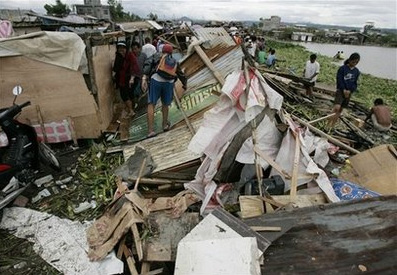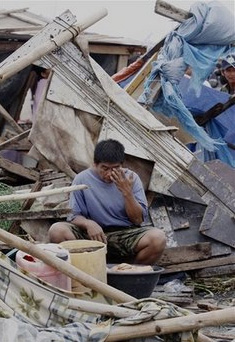Typhoon Mirinae attacked the Philippines
This morning, October 31, Hurricane Mirinae with 150 km / h winds brought heavy rain to the Philippine capital of Manila, causing widespread power outages, dumping many trees and causing flooding in the remaining areas. there is also flooding caused by the previous storm.
Mirinae is the fourth largest storm to hit the Philippines in just one month, after Ketsana, Parma and Lupit.
More than 100,000 people had to evacuate and live in makeshift huts in five provinces in the east and south of the Philippines following the path of Typhoon Mirinae on Luzon Island. A river in Lagua province in southern Manila was overflowed, flooding most of the riverside town of Santa Cruz and causing people to climb onto the roof to escape the rising flood.

A corner of Taytay town in Rizal province, east of Manila, after the storm Mirinae swept.
' We can't move, this is no joke. The water level is rising. We need help , 'said Mayor Ariel Magcalas via radio.
Rescue teams were dispatched to flooded areas, but truck travel was difficult. ' Currently, we focus on evacuation and rescue, ' said Fred Bragas, a local disaster relief worker. There have been no reports of damage and casualties.
In the capital Manila, people have reinforced their homes last night when rain poured down. Typhoon Mirinae swept south of the 12-million city with winds of 150 km / h, and winds of 185 km / h.

Rodrigo Tabin is among the ruins of a house destroyed by Typhoon Mirinae.
Typhoon Mirinae has a similar path to Typhoon Ketsana - a hurricane hit the Philippines on September 26, causing record rain in the past 40 years in Manila and surrounding areas.
The storms caused by the Ketsana storm in just 12 hours by the month's rainfall caused hundreds of deaths, thousands of people trapped in cars, on the roof.
Local radio stations said that strong winds caused by typhoon Mirinae dumped trees and wires, causing traffic jams on some highways. Strong winds also caused many areas in the capital and surrounding areas to lose power. Train service is interrupted. Flights at Manila international airport were delayed and about 8,000 ferry passengers were stranded.
Unlike Typhoon Ketsana, Typhoon Mirinae moves quickly at 24 km / h. Mirinae is expected to cross the Philippines today and head to Vietnam.
In Albay Province, at least 10,000 people live near rivers and next to the volcano Mayon has left their homes. Mayon - located in the eastern Philippines, is one of the most active volcanoes in the country. Authorities fear that heavy rains can wash away the sand and dust caused by volcanic eruptions in the past, burying villages.
Meanwhile, the northern Philippines is still struggling to overcome the consequences of previous storms that claimed the lives of 929 people . In some provinces, the country was flooded with graveyards, ruined the insults, swept away the coffins and corpses.
About 122,000 people still live in evacuation centers set up by the government. Many areas in suburban Manila are still submerged and people have to use homemade rafts to move.
- Typhoon Mirinae faces the Northern Delta
- East Sea is about to have strong storms
- Typhoon Mirinae in Nam Dinh - Ninh Binh
- Typhoon Mirinae - Storm No. 1 toward Hai Phong
- No.1 storm suddenly changed direction, can go through Hai Phong, Hanoi
- Photo: Super typhoon Yutu caused heavy damage when landing in the Philippines
- Super typhoon Nanmadol swept through the Philippines
- Philippines confirmed 1,774 people died of Typhoon Haiyan
- 10,000 people may have died due to Typhoon Haiyan in the Philippines
- Typhoon Parma and Melor are very strong and complex
- The world's strongest storm hit the Philippines
- Philippines copes with new super typhoon
 Is the magnetic North Pole shift dangerous to humanity?
Is the magnetic North Pole shift dangerous to humanity? Washington legalizes the recycling of human bodies into fertilizer
Washington legalizes the recycling of human bodies into fertilizer Lightning stone - the mysterious guest
Lightning stone - the mysterious guest Stunned by the mysterious sunset, strange appearance
Stunned by the mysterious sunset, strange appearance